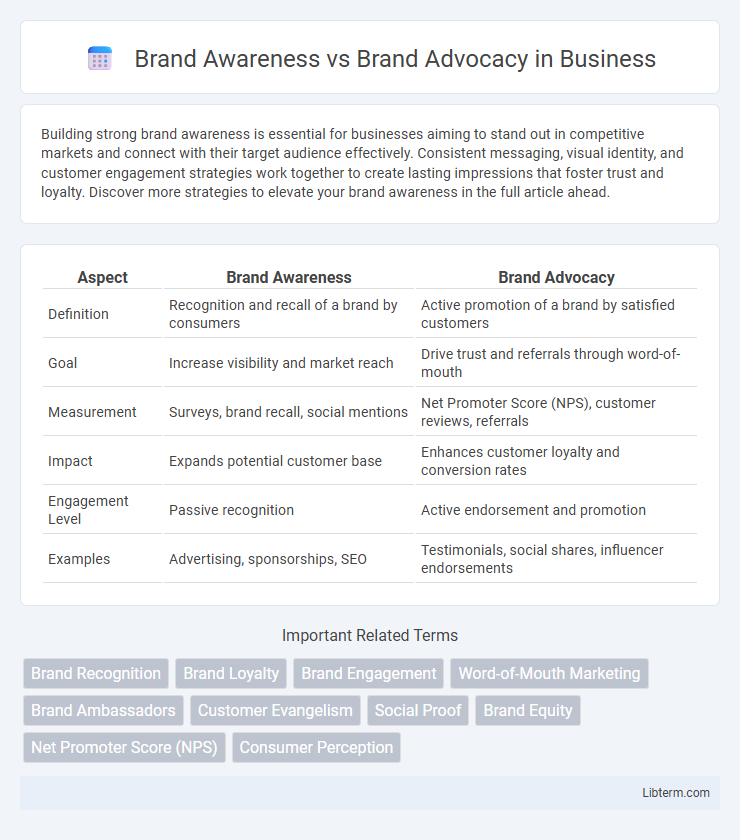Building strong brand awareness is essential for businesses aiming to stand out in competitive markets and connect with their target audience effectively. Consistent messaging, visual identity, and customer engagement strategies work together to create lasting impressions that foster trust and loyalty. Discover more strategies to elevate your brand awareness in the full article ahead.
Table of Comparison
| Aspect | Brand Awareness | Brand Advocacy |
|---|---|---|
| Definition | Recognition and recall of a brand by consumers | Active promotion of a brand by satisfied customers |
| Goal | Increase visibility and market reach | Drive trust and referrals through word-of-mouth |
| Measurement | Surveys, brand recall, social mentions | Net Promoter Score (NPS), customer reviews, referrals |
| Impact | Expands potential customer base | Enhances customer loyalty and conversion rates |
| Engagement Level | Passive recognition | Active endorsement and promotion |
| Examples | Advertising, sponsorships, SEO | Testimonials, social shares, influencer endorsements |
Understanding Brand Awareness: Definition and Importance
Brand awareness refers to the extent to which consumers recognize and recall a brand, influencing their purchasing decisions and loyalty. It is crucial for businesses because high brand awareness increases market share, enhances consumer trust, and drives repeat sales. Building strong brand awareness involves consistent marketing, unique brand identity, and emotional connections that differentiate the brand from competitors.
Exploring Brand Advocacy: What Sets It Apart?
Brand advocacy goes beyond brand awareness by fostering genuine emotional connections and trust, turning customers into passionate promoters who actively recommend and defend the brand. Unlike brand awareness, which measures recognition and recall, brand advocacy reflects loyalty and engagement through positive word-of-mouth and social proof. Key drivers include exceptional customer experiences, personalized interactions, and consistent value delivery that inspire customers to voluntarily champion the brand.
Key Differences Between Brand Awareness and Brand Advocacy
Brand awareness measures how familiar consumers are with a brand's name, logo, or products, while brand advocacy reflects customers' active promotion and recommendation of the brand to others. Brand awareness serves as the initial step in the customer journey, focusing on recognition and recall, whereas brand advocacy indicates a deeper emotional connection and trust, often driven by positive experiences and satisfaction. Metrics for brand awareness include reach and impressions, whereas brand advocacy is tracked through referrals, reviews, and word-of-mouth engagement.
The Role of Brand Awareness in Marketing Strategy
Brand awareness serves as the foundation of marketing strategy by ensuring potential customers recognize and recall a brand, which increases the likelihood of purchase decisions. High brand awareness boosts market share and supports new product launches by generating familiarity and trust. Effective marketing campaigns leverage brand awareness to enhance visibility, driving customer engagement and paving the way for strong brand advocacy.
How Brand Advocacy Drives Customer Loyalty
Brand advocacy transforms satisfied customers into passionate promoters who actively recommend a brand, significantly enhancing customer loyalty through trust and authentic endorsements. Unlike brand awareness, which simply increases recognition, brand advocacy fosters emotional connections that motivate repeat purchases and strengthen long-term relationships. Companies leveraging brand advocates experience higher retention rates and more effective word-of-mouth marketing, driving sustainable growth and deeper consumer commitment.
Metrics: Measuring Brand Awareness vs Brand Advocacy
Brand awareness metrics include reach, impressions, website traffic, social media mentions, and aided or unaided brand recall surveys, indicating how well consumers recognize or remember a brand. Brand advocacy metrics focus on customer loyalty, Net Promoter Score (NPS), referral rates, user-generated content, and positive reviews, showcasing the extent of active recommendations from satisfied customers. Tracking these distinct metrics helps businesses evaluate both the visibility and the genuine customer support driving long-term growth.
Building Brand Awareness: Strategies That Work
Building brand awareness involves strategies such as leveraging social media marketing, content creation, and influencer partnerships to increase visibility and recognition among target audiences. Consistent messaging, memorable logos, and engaging storytelling cultivate emotional connections that drive recall and preference. Utilizing SEO best practices and targeted advertising further enhances reach, making the brand more discoverable and top-of-mind for consumers.
Fostering Brand Advocacy: Tactics for Success
Fostering brand advocacy requires delivering exceptional customer experiences that inspire loyalty and genuine endorsements. Engaging customers through personalized interactions, loyalty programs, and social proof tactics amplifies positive word-of-mouth and cultivates a passionate community. Leveraging user-generated content and influencer partnerships enhances brand credibility, transforming satisfied customers into powerful advocates.
The Interplay: How Brand Awareness Fuels Advocacy
Brand awareness serves as the foundation for brand advocacy by familiarizing consumers with a brand's identity, values, and offerings, making it easier to cultivate trust and emotional connection. Increased brand awareness expands the pool of potential advocates who can share positive experiences and recommend the brand authentically. This synergy between recognition and endorsement amplifies brand credibility, driving organic growth and long-term customer loyalty.
Choosing the Right Focus: Awareness, Advocacy, or Both?
Choosing between brand awareness and brand advocacy depends on business goals and customer engagement levels; awareness drives broader recognition while advocacy fosters trust through customer loyalty. Brands targeting market expansion should prioritize awareness to capture new audiences, whereas those seeking long-term growth benefit from advocacy by leveraging satisfied customers as brand ambassadors. Integrating both strategies maximizes reach and credibility, creating a balanced marketing approach that elevates brand visibility and deepens consumer connections.
Brand Awareness Infographic

 libterm.com
libterm.com